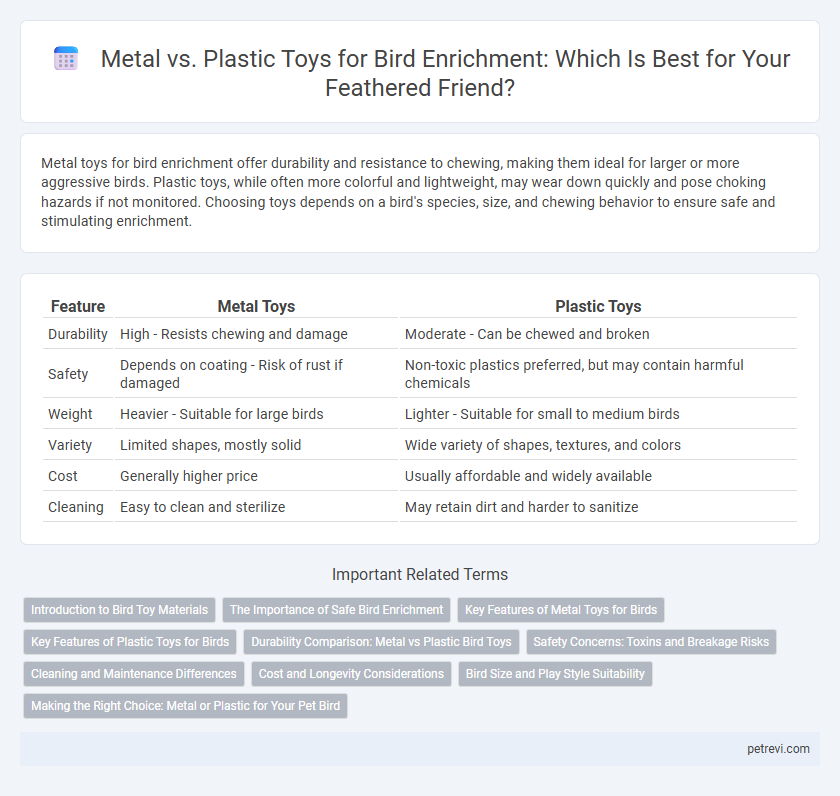Metal toys for bird enrichment offer durability and resistance to chewing, making them ideal for larger or more aggressive birds. Plastic toys, while often more colorful and lightweight, may wear down quickly and pose choking hazards if not monitored. Choosing toys depends on a bird's species, size, and chewing behavior to ensure safe and stimulating enrichment.
Table of Comparison
| Feature | Metal Toys | Plastic Toys |
|---|---|---|
| Durability | High - Resists chewing and damage | Moderate - Can be chewed and broken |
| Safety | Depends on coating - Risk of rust if damaged | Non-toxic plastics preferred, but may contain harmful chemicals |
| Weight | Heavier - Suitable for large birds | Lighter - Suitable for small to medium birds |
| Variety | Limited shapes, mostly solid | Wide variety of shapes, textures, and colors |
| Cost | Generally higher price | Usually affordable and widely available |
| Cleaning | Easy to clean and sterilize | May retain dirt and harder to sanitize |
Introduction to Bird Toy Materials
Metal bird toys offer superior durability and resistance to chewing, making them ideal for larger or more aggressive bird species, while plastic toys provide a lightweight, colorful option that can stimulate visual interest for smaller birds. Non-toxic, bird-safe metals such as stainless steel avoid rust and are easily sanitized, ensuring safe and hygienic enrichment. High-quality, BPA-free plastics are preferred for their safety, but should be replaced frequently to avoid ingestion of worn pieces.
The Importance of Safe Bird Enrichment
Safe bird enrichment is crucial for promoting mental stimulation and physical activity, with metal toys offering durability and resistance to chewing, reducing the risk of ingestion hazards common in plastic toys. Non-toxic stainless steel and aluminum are preferred metal materials, ensuring the absence of harmful chemicals that can be present in some plastics. Choosing secure, bird-safe materials helps prevent toxicity and injury, fostering a healthy and engaging environment for pet birds.
Key Features of Metal Toys for Birds
Metal toys for bird enrichment offer superior durability and resistance to chewing compared to plastic alternatives, making them ideal for aggressive bird species like parrots. These toys often feature stainless steel components that resist rust and provide a safe, non-toxic environment. The heavy-duty construction and varied textures of metal toys stimulate birds' natural foraging and problem-solving behaviors effectively.
Key Features of Plastic Toys for Birds
Plastic toys for bird enrichment offer lightweight, durable designs that resist corrosion and are easy to clean, ensuring safe and hygienic play environments. They often feature bright colors and varied textures that stimulate birds' visual and tactile senses, promoting mental engagement and reducing boredom. Non-toxic, BPA-free plastic materials provide a safe alternative to metal toys, minimizing risks of injury and metal toxicity in birds.
Durability Comparison: Metal vs Plastic Bird Toys
Metal bird toys offer superior durability compared to plastic, withstanding aggressive chewing and long-term wear without breaking or deforming. Plastic toys, while often lighter and more colorful, tend to crack or shatter more easily under a bird's strong beak pressure, posing potential safety risks. Choosing metal toys ensures a longer-lasting and safer enrichment tool for birds with aggressive play habits.
Safety Concerns: Toxins and Breakage Risks
Metal bird toys often pose lower toxicity risks compared to plastic, as high-quality metals like stainless steel are non-toxic and durable, minimizing potential chemical exposure. However, plastic toys can release harmful toxins, especially if made from low-grade materials containing BPA or phthalates, which can negatively affect bird health. Breakage risks are also critical, as shattered plastic pieces can cause injury or ingestion hazards, whereas metal toys generally resist breakage while still requiring regular inspection for sharp edges.
Cleaning and Maintenance Differences
Metal bird toys offer superior durability and resist damage from chewing, making them easier to clean with simple disinfection methods like boiling or using bird-safe cleaners. Plastic toys, while lightweight and colorful, can harbor bacteria in scratches and cracks, requiring more frequent and thorough cleaning to prevent infections. Regular maintenance of metal toys promotes longevity and bird safety, whereas plastic toys often need replacement due to wear and hygiene concerns.
Cost and Longevity Considerations
Metal bird toys generally offer greater longevity and durability, justifying their higher initial cost through extended use and reduced replacement frequency. Plastic toys are often less expensive upfront but may degrade or break more quickly, potentially increasing long-term expenses. Evaluating cost-effectiveness involves balancing the initial investment against durability and the bird's safety, with metal toys typically providing better value over time.
Bird Size and Play Style Suitability
Metal toys offer durability and are ideal for large birds like macaws and cockatoos that use strong beaks for shredding and climbing, ensuring long-lasting enrichment. Plastic toys suit smaller birds such as budgerigars and finches, providing lightweight, colorful options that accommodate delicate play styles without risk of injury. Matching the material with the bird's size and play behavior enhances safety, engagement, and overall mental stimulation.
Making the Right Choice: Metal or Plastic for Your Pet Bird
Choosing the right material for bird enrichment toys significantly impacts your pet's safety and engagement. Metal toys offer durability, resistance to chewing, and are often coated with non-toxic paints, making them ideal for heavy chewers and larger birds prone to destruction of plastic toys. In contrast, plastic toys, though lighter and available in vibrant colors, may pose ingestion risks if not made from bird-safe, BPA-free materials and generally suit smaller, less aggressive birds better due to their susceptibility to breakage.
Metal vs Plastic toys for Bird enrichment Infographic

 petrevi.com
petrevi.com